
zeta
Build high-performance AI models with modular building blocks
Stars: 365
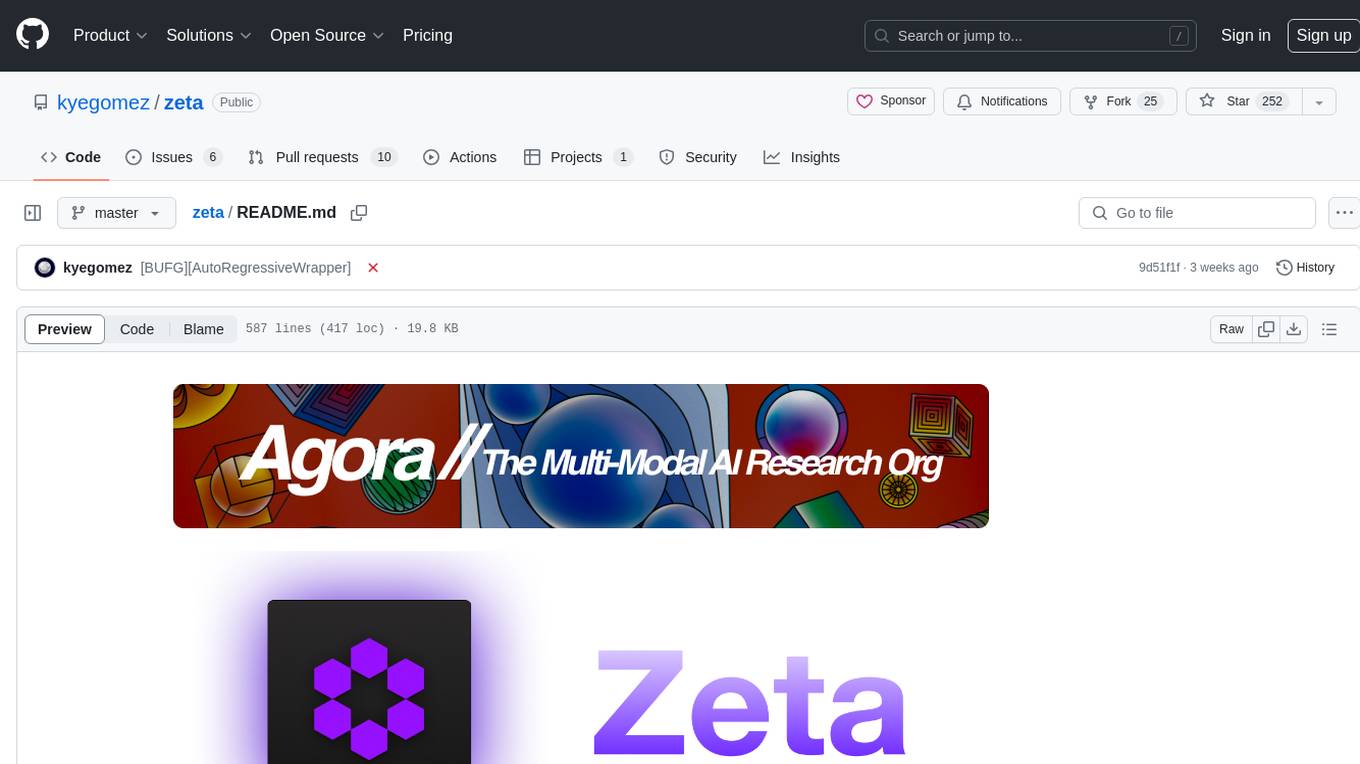
Zeta is a tool designed to build state-of-the-art AI models faster by providing modular, high-performance, and scalable building blocks. It addresses the common issues faced while working with neural nets, such as chaotic codebases, lack of modularity, and low performance modules. Zeta emphasizes usability, modularity, and performance, and is currently used in hundreds of models across various GitHub repositories. It enables users to prototype, train, optimize, and deploy the latest SOTA neural nets into production. The tool offers various modules like FlashAttention, SwiGLUStacked, RelativePositionBias, FeedForward, BitLinear, PalmE, Unet, VisionEmbeddings, niva, FusedDenseGELUDense, FusedDropoutLayerNorm, MambaBlock, Film, hyper_optimize, DPO, and ZetaCloud for different tasks in AI model development.
README:
 Build SOTA AI Models 80% faster with modular, high-performance, and scalable building blocks!
Build SOTA AI Models 80% faster with modular, high-performance, and scalable building blocks!
After building out thousands of neural nets and facing the same annoying bottlenecks of chaotic codebases with no modularity and low performance modules, Zeta needed to be born to enable me and others to quickly prototype, train, and optimize the latest SOTA neural nets and deploy them into production.
Zeta places a radical emphasis on useability, modularity, and performance. Zeta is now currently employed in 100s of models across my github and across others. Get started below and LMK if you want my help building any model, I'm here for you 😊 💜
$ pip3 install -U zetascaleCreating a model empowered with the aforementioned breakthrough research features is a breeze. Here's how to quickly materialize the renowned Multi Query Attention
import torch
from zeta import MultiQueryAttention
# Model
model = MultiQueryAttention(
dim=512,
heads=8,
)
# Input
text = torch.randn(2, 4, 512)
# Output
output, _, _ = model(text)
print(output.shape)
print(output)The SwiGLU activation function takes an input tensor and applies a gating mechanism to selectively pass information. It consists of two parts: the "switch" gate and the "glu" gate. The switch gate controls the flow of information, while the glu gate performs a non-linear transformation on the input.
import torch
from zeta.nn import SwiGLUStacked
x = torch.randn(5, 10)
swiglu = SwiGLUStacked(10, 20)
swiglu(x).shapeIn this example, we first import the necessary modules, including torch for tensor operations and SwiGLUStacked from zeta.nn for the SwiGLU activation function.
We then create a random input tensor x with a shape of (5, 10). Next, we instantiate an instance of SwiGLUStacked with an input size of 10 and an output size of 20.
Finally, we pass the input tensor x to the swiglu module, which applies the SwiGLU activation function to it. The resulting output tensor is stored in the output variable. We print the shape of the output tensor to see the
-
RelativePositionBiasquantizes the distance between two positions into a certain number of buckets and then uses an embedding to get the relative position bias. This mechanism aids in the attention mechanism by providing biases based on relative positions between the query and key, rather than relying solely on their absolute positions.
import torch
from torch import nn
from zeta.nn import RelativePositionBias
# Initialize the RelativePositionBias module
rel_pos_bias = RelativePositionBias()
# Example 1: Compute bias for a single batch
bias_matrix = rel_pos_bias(1, 10, 10)
# Example 2: Utilize in conjunction with an attention mechanism
# NOTE: This is a mock example, and may not represent an actual attention mechanism's complete implementation.
class MockAttention(nn.Module):
def __init__(self):
super().__init__()
self.rel_pos_bias = RelativePositionBias()
def forward(self, queries, keys):
bias = self.rel_pos_bias(queries.size(0), queries.size(1), keys.size(1))
# Further computations with bias in the attention mechanism...
return None # Placeholder
# Example 3: Modify default configurations
custom_rel_pos_bias = RelativePositionBias(
bidirectional=False, num_buckets=64, max_distance=256, num_heads=8
)The FeedForward module performs a feedforward operation on the input tensor x. It consists of a multi-layer perceptron (MLP) with an optional activation function and LayerNorm. Used in most language, multi-modal, and modern neural networks.
import torch
from zeta.nn import FeedForward
model = FeedForward(256, 512, glu=True, post_act_ln=True, dropout=0.2)
x = torch.randn(1, 256)
output = model(x)
print(output.shape)- The BitLinear module performs linear transformation on the input data, followed by quantization and dequantization. The quantization process is performed using the absmax_quantize function, which quantizes the input tensor based on the absolute maximum value, from the paper
import torch
from torch import nn
import zeta.quant as qt
class MyModel(nn.Module):
def __init__(self):
super().__init__()
self.linear = qt.BitLinear(10, 20)
def forward(self, x):
return self.linear(x)
# Initialize the model
model = MyModel()
# Create a random tensor of size (128, 10)
input = torch.randn(128, 10)
# Perform the forward pass
output = model(input)
# Print the size of the output
print(output.size()) # torch.Size([128, 20])- This is an implementation of the multi-modal Palm-E model using a decoder llm as the backbone with an VIT image encoder to process vision, it's very similiar to GPT4, Kosmos, RTX2, and many other multi-modality model architectures
import torch
from zeta.structs import (
AutoRegressiveWrapper,
Decoder,
Encoder,
Transformer,
ViTransformerWrapper,
)
class PalmE(torch.nn.Module):
"""
PalmE is a transformer architecture that uses a ViT encoder and a transformer decoder.
Args:
image_size (int): Size of the image.
patch_size (int): Size of the patch.
encoder_dim (int): Dimension of the encoder.
encoder_depth (int): Depth of the encoder.
encoder_heads (int): Number of heads in the encoder.
num_tokens (int): Number of tokens.
max_seq_len (int): Maximum sequence length.
decoder_dim (int): Dimension of the decoder.
decoder_depth (int): Depth of the decoder.
decoder_heads (int): Number of heads in the decoder.
alibi_num_heads (int): Number of heads in the alibi attention.
attn_kv_heads (int): Number of heads in the attention key-value projection.
use_abs_pos_emb (bool): Whether to use absolute positional embeddings.
cross_attend (bool): Whether to cross attend in the decoder.
alibi_pos_bias (bool): Whether to use positional bias in the alibi attention.
rotary_xpos (bool): Whether to use rotary positional embeddings.
attn_flash (bool): Whether to use attention flash.
qk_norm (bool): Whether to normalize the query and key in the attention layer.
Returns:
torch.Tensor: The output of the model.
Usage:
img = torch.randn(1, 3, 256, 256)
text = torch.randint(0, 20000, (1, 1024))
model = PalmE()
output = model(img, text)
print(output)
"""
def __init__(
self,
image_size=256,
patch_size=32,
encoder_dim=512,
encoder_depth=6,
encoder_heads=8,
num_tokens=20000,
max_seq_len=1024,
decoder_dim=512,
decoder_depth=6,
decoder_heads=8,
alibi_num_heads=4,
attn_kv_heads=2,
use_abs_pos_emb=False,
cross_attend=True,
alibi_pos_bias=True,
rotary_xpos=True,
attn_flash=True,
qk_norm=True,
):
super().__init__()
# vit architecture
self.encoder = ViTransformerWrapper(
image_size=image_size,
patch_size=patch_size,
attn_layers=Encoder(
dim=encoder_dim, depth=encoder_depth, heads=encoder_heads
),
)
# palm model architecture
self.decoder = Transformer(
num_tokens=num_tokens,
max_seq_len=max_seq_len,
use_abs_pos_emb=use_abs_pos_emb,
attn_layers=Decoder(
dim=decoder_dim,
depth=decoder_depth,
heads=decoder_heads,
cross_attend=cross_attend,
alibi_pos_bias=alibi_pos_bias,
alibi_num_heads=alibi_num_heads,
rotary_xpos=rotary_xpos,
attn_kv_heads=attn_kv_heads,
attn_flash=attn_flash,
qk_norm=qk_norm,
),
)
# autoregressive wrapper to enable generation of tokens
self.decoder = AutoRegressiveWrapper(self.decoder)
def forward(self, img: torch.Tensor, text: torch.Tensor):
"""Forward pass of the model."""
try:
encoded = self.encoder(img, return_embeddings=True)
return self.decoder(text, context=encoded)
except Exception as error:
print(f"Failed in forward method: {error}")
raise
# Usage with random inputs
img = torch.randn(1, 3, 256, 256)
text = torch.randint(0, 20000, (1, 1024))
# Initiliaze the model
model = PalmE()
output = model(img, text)
print(output)Unet is a famous convolutional neural network architecture originally used for biomedical image segmentation but soon became the backbone of the generative AI Mega-revolution. The architecture comprises two primary pathways: downsampling and upsampling, followed by an output convolution. Due to its U-shape, the architecture is named U-Net. Its symmetric architecture ensures that the context (from downsampling) and the localization (from upsampling) are captured effectively.
import torch
from zeta.nn import Unet
# Initialize the U-Net model
model = Unet(n_channels=1, n_classes=2)
# Random input tensor with dimensions [batch_size, channels, height, width]
x = torch.randn(1, 1, 572, 572)
# Forward pass through the model
y = model(x)
# Output
print(f"Input shape: {x.shape}")
print(f"Output shape: {y.shape}")The VisionEmbedding class is designed for converting images into patch embeddings, making them suitable for processing by transformer-based models. This class plays a crucial role in various computer vision tasks and enables the integration of vision data into transformer architectures!
import torch
from zeta.nn import VisionEmbedding
# Create an instance of VisionEmbedding
vision_embedding = VisionEmbedding(
img_size=224,
patch_size=16,
in_chans=3,
embed_dim=768,
contain_mask_token=True,
prepend_cls_token=True,
)
# Load an example image (3 channels, 224x224)
input_image = torch.rand(1, 3, 224, 224)
# Perform image-to-patch embedding
output = vision_embedding(input_image)
# The output now contains patch embeddings, ready for input to a transformer model- Niva focuses on weights of certain layers (specified by quantize_layers). Ideal for models where runtime activation is variable. 👁️ Example Layers: nn.Embedding, nn.LSTM.
import torch
from zeta import niva
# Load a pre-trained model
model = YourModelClass()
# Quantize the model dynamically, specifying layers to quantize
niva(
model=model,
model_path="path_to_pretrainedim_weights.pt",
output_path="quantizedim.pt",
quant_type="dynamic",
quantize_layers=[nn.Linear, nn.Conv2d],
dtype=torch.qint8,
)- Increase model speed by 2x with this module that fuses together 2 hyper-optimized dense ops from bits and bytes and a gelu together!
import torch
from zeta.nn import FusedDenseGELUDense
x = torch.randn(1, 512)
model = FusedDenseGELUDense(512, 1024)
out = model(x)
out.shape- FusedDropoutLayerNorm is a fused kernel of dropout and layernorm to speed up FFNs or MLPS by 2X
import torch
from torch import nn
from zeta.nn import FusedDropoutLayerNorm
# Initialize the module
model = FusedDropoutLayerNorm(dim=512)
# Create a sample input tensor
x = torch.randn(1, 512)
# Forward pass
output = model(x)
# Check output shape
print(output.shape) # Expected: torch.Size([1, 512])- Pytorch implementation of the new SSM model architecture Mamba
import torch
from zeta.nn import MambaBlock
# Initialize Mamba
block = MambaBlock(dim=64, depth=1)
# Random input
x = torch.randn(1, 10, 64)
# Apply the model to the block
y = block(x)
print(y.shape)
# torch.Size([1, 10, 64])import torch
from zeta.nn import Film
# Initialize the Film layer
film_layer = Film(dim=128, hidden_dim=64, expanse_ratio=4)
# Create some dummy data for conditions and hiddens
conditions = torch.randn(10, 128) # Batch size is 10, feature size is 128
hiddens = torch.randn(
10, 1, 128
) # Batch size is 10, sequence length is 1, feature size is 128
# Pass the data through the Film layer
modulated_features = film_layer(conditions, hiddens)
# Print the shape of the output
print(modulated_features.shape) # Should be [10, 1, 128]- A single wrapper for torch.fx, torch.script, torch.compile, dynamic quantization, mixed precision through torch.amp, with execution time metrics all in once place!
import torch
from zeta.nn import hyper_optimize
@hyper_optimize(
torch_fx=False,
torch_script=False,
torch_compile=True,
quantize=True,
mixed_precision=True,
enable_metrics=True,
)
def model(x):
return x @ x
out = model(torch.randn(1, 3, 32, 32))
print(out)Direct Policy Optimization employed for many RLHF applications for LLMs.
import torch
from torch import nn
from zeta.rl import DPO
# Define a simple policy model
class PolicyModel(nn.Module):
def __init__(self, dim, output_dim):
super().__init__()
self.fc = nn.Linear(dim, output_dim)
def forward(self, x):
return self.fc(x)
dim = 10
output_dim = 5
policy_model = PolicyModel(dim, output_dim)
# Initialize DPO with the policy model
dpo_model = DPO(model=policy_model, beta=0.1)
# Sample preferred and unpreferred sequences
preferred_seq = torch.randint(0, output_dim, (3, dim))
unpreferred_seq = torch.randint(0, output_dim, (3, dim))
# Compute loss
loss = dpo_model(preferred_seq, unpreferred_seq)
print(loss)- A decorator that logs the execution of the pytorch model, including parameters, gradients, and memory usage.
from zeta.utils import verbose_execution
import torch
from torch import nn
from zeta.utils.verbose_execution import verbose_execution
# # Configure Loguru (optional)
@verbose_execution(log_params=True, log_gradients=True, log_memory=True)
class YourPyTorchModel(nn.Module):
def __init__(self):
super().__init__()
self.conv1 = nn.Conv2d(3, 64, 3)
self.relu = nn.ReLU()
self.flatten = nn.Flatten()
self.fc = nn.Linear(64 * 222 * 222, 10) # Adjusted input size
def forward(self, x):
x = self.conv1(x)
x = self.relu(x)
x = self.flatten(x)
x = self.fc(x)
return x
# Create and use your model
model = YourPyTorchModel()
input_tensor = torch.randn(1, 3, 224, 224)
output = model(input_tensor)
# If you want to see gradient information, you need to perform a backward pass
loss = output.sum()
loss.backward()All classes must have documentation if you see a class or function without documentation then please report it to me at [email protected],
Documentation is at zeta.apac.ai
You should install the pre-commit hooks with pre-commit install. This will run the linter, mypy, and a subset of the tests on every commit.
For more examples on how to run the full test suite please refer to the CI workflow.
Some examples of running tests locally:
python3 -m pip install -e '.[testing]' # install extra deps for testing
python3 -m pytest tests/ # whole test suiteJoin our growing community around the world, for real-time support, ideas, and discussions on how to build better models 😊
- View our official Docs
- Chat live with us on Discord
- Follow us on Twitter
- Connect with us on LinkedIn
- Visit us on YouTube
- Join the Swarms community on Discord!
Want to train a custom AI model for a real-world task like General Multi-Modal Models, Facial Recognitions, Drug Discovery, Humanoid Robotics? I'll help you create the model architecture then train the model and then optimize it to meet your quality assurance standards.
Book a 1-on-1 Session with Kye here., the Creator, to discuss any issues, provide feedback, or explore how we can improve Zeta for you or help you build your own custom models!
The easiest way to contribute is to pick any issue with the good first issue tag 💪. Read the Contributing guidelines here. Bug Report? File here | Feature Request? File here
Zeta is an open-source project, and contributions are VERY welcome. If you want to contribute, you can create new features, fix bugs, or improve the infrastructure. Please refer to the CONTRIBUTING.md and our contributing board to participate in Roadmap discussions!
Help us accelerate our backlog by supporting us financially! Note, we're an open source corporation and so all the revenue we generate is through donations at the moment ;)
- Apache
@misc{zetascale,
title = {Zetascale Framework},
author = {Kye Gomez},
year = {2024},
howpublished = {\url{https://github.com/kyegomez/zeta}},
}For Tasks:
Click tags to check more tools for each tasksFor Jobs:
Alternative AI tools for zeta
Similar Open Source Tools

zeta
Zeta is a tool designed to build state-of-the-art AI models faster by providing modular, high-performance, and scalable building blocks. It addresses the common issues faced while working with neural nets, such as chaotic codebases, lack of modularity, and low performance modules. Zeta emphasizes usability, modularity, and performance, and is currently used in hundreds of models across various GitHub repositories. It enables users to prototype, train, optimize, and deploy the latest SOTA neural nets into production. The tool offers various modules like FlashAttention, SwiGLUStacked, RelativePositionBias, FeedForward, BitLinear, PalmE, Unet, VisionEmbeddings, niva, FusedDenseGELUDense, FusedDropoutLayerNorm, MambaBlock, Film, hyper_optimize, DPO, and ZetaCloud for different tasks in AI model development.
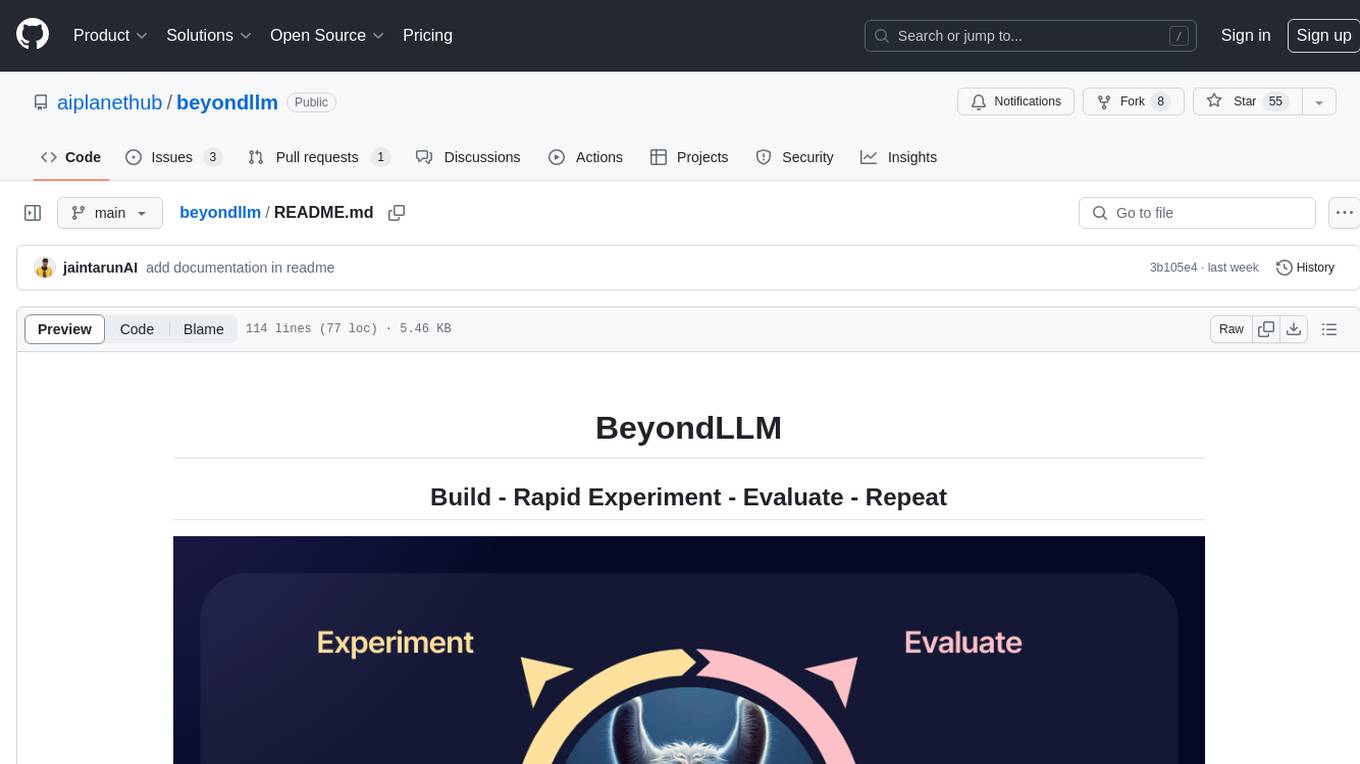
beyondllm
Beyond LLM offers an all-in-one toolkit for experimentation, evaluation, and deployment of Retrieval-Augmented Generation (RAG) systems. It simplifies the process with automated integration, customizable evaluation metrics, and support for various Large Language Models (LLMs) tailored to specific needs. The aim is to reduce LLM hallucination risks and enhance reliability.
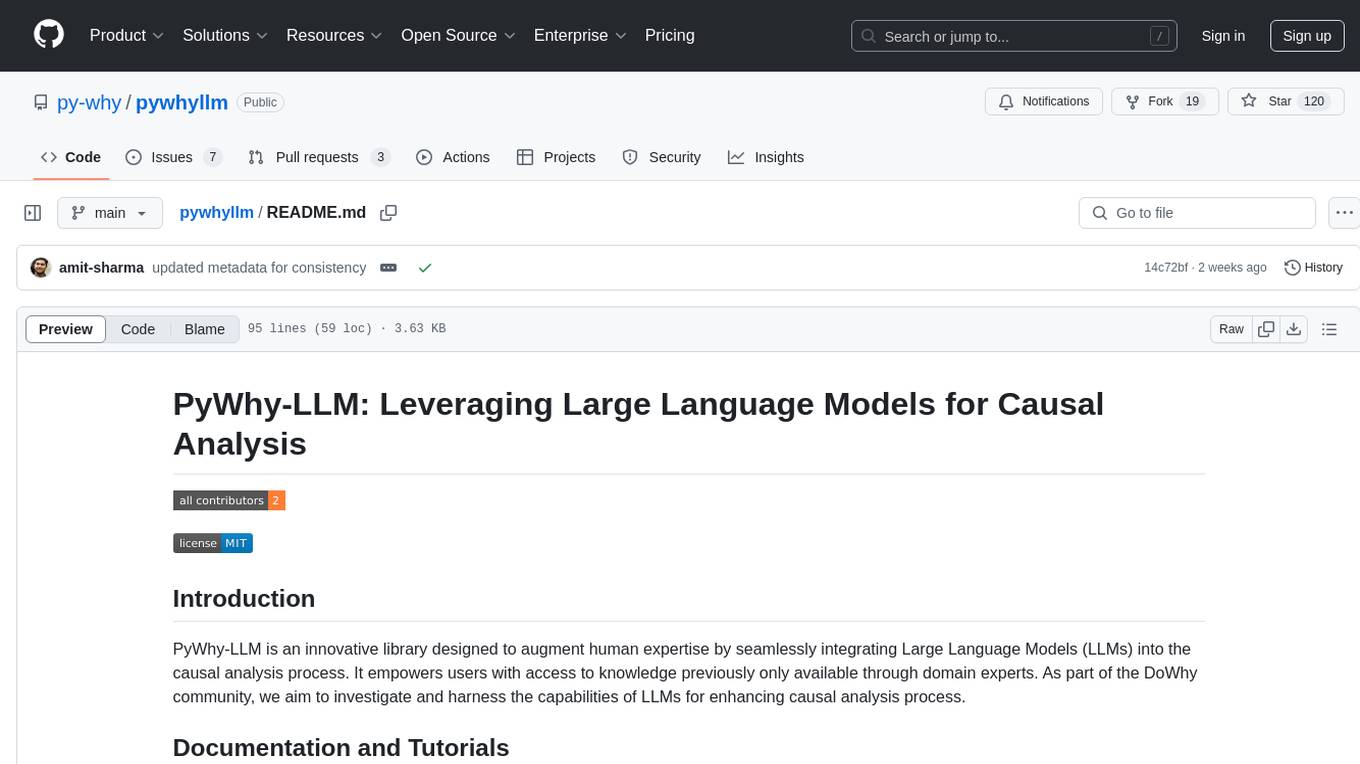
pywhyllm
PyWhy-LLM is an innovative library that integrates Large Language Models (LLMs) into the causal analysis process, empowering users with knowledge previously only available through domain experts. It seamlessly augments causal inference by suggesting potential confounders, relationships between variables, backdoor/frontdoor/iv sets, estimands, critiques of DAGs, latent confounders, and negative controls. The tool aims to enhance the causal analysis process by leveraging the capabilities of LLMs.
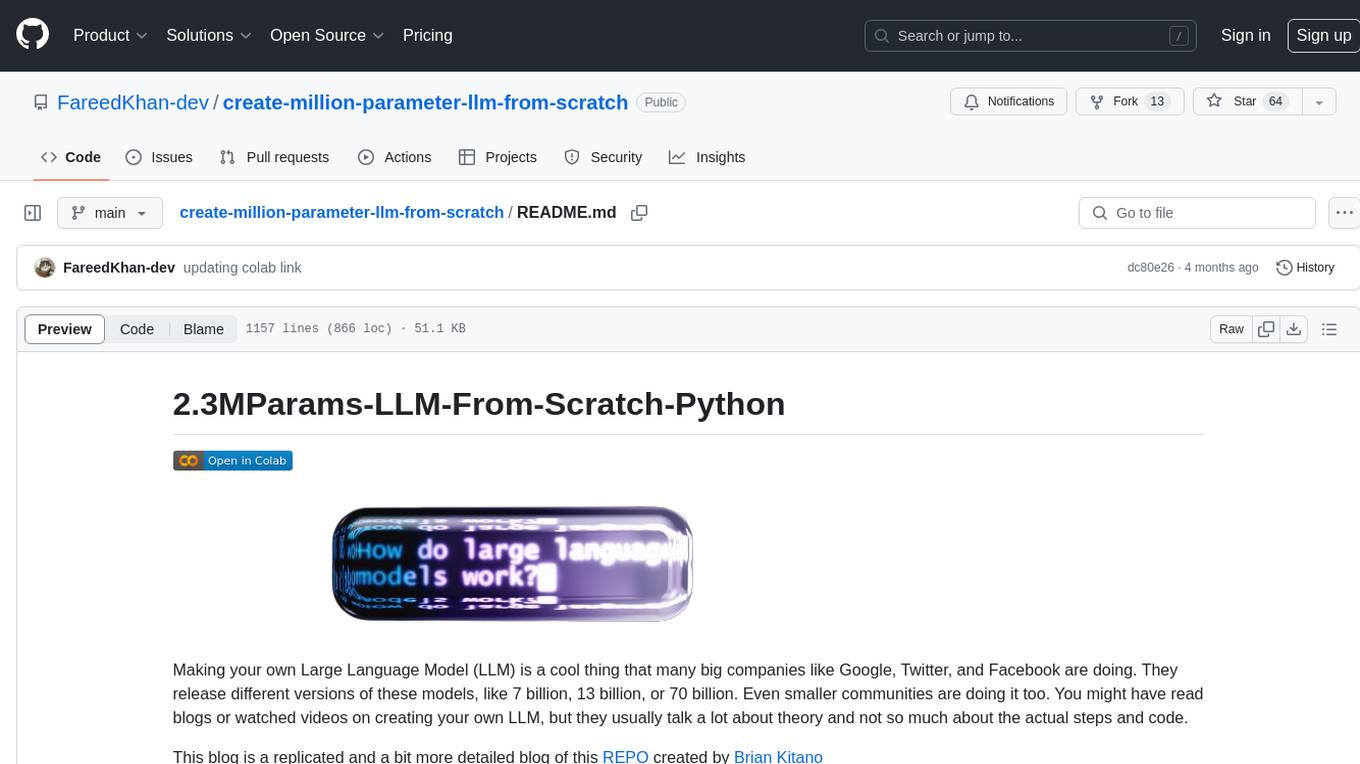
create-million-parameter-llm-from-scratch
The 'create-million-parameter-llm-from-scratch' repository provides a detailed guide on creating a Large Language Model (LLM) with 2.3 million parameters from scratch. The blog replicates the LLaMA approach, incorporating concepts like RMSNorm for pre-normalization, SwiGLU activation function, and Rotary Embeddings. The model is trained on a basic dataset to demonstrate the ease of creating a million-parameter LLM without the need for a high-end GPU.
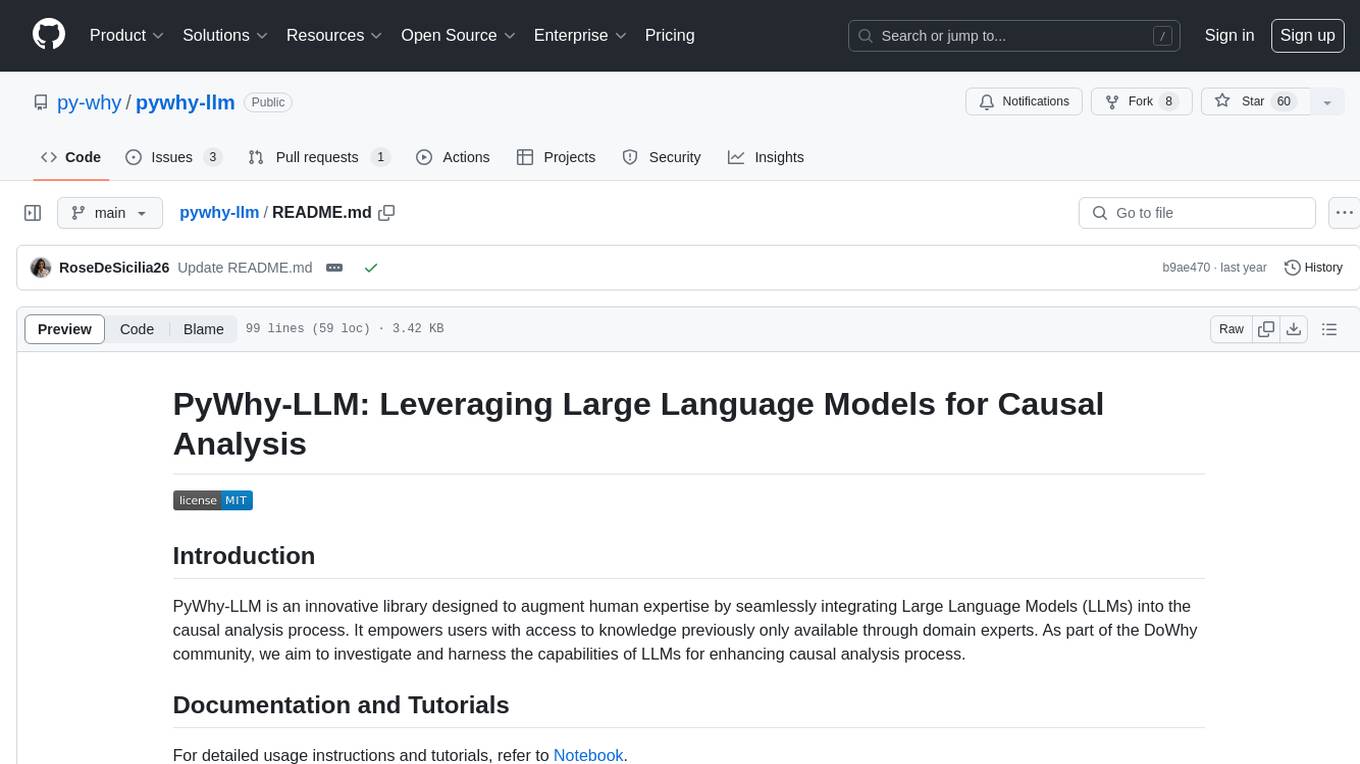
pywhy-llm
PyWhy-LLM is an innovative library that integrates Large Language Models (LLMs) into the causal analysis process, empowering users with knowledge previously only available through domain experts. It seamlessly augments existing causal inference processes by suggesting potential confounders, relationships between variables, backdoor sets, front door sets, IV sets, estimands, critiques of DAGs, latent confounders, and negative controls. By leveraging LLMs and formalizing human-LLM collaboration, PyWhy-LLM aims to enhance causal analysis accessibility and insight.
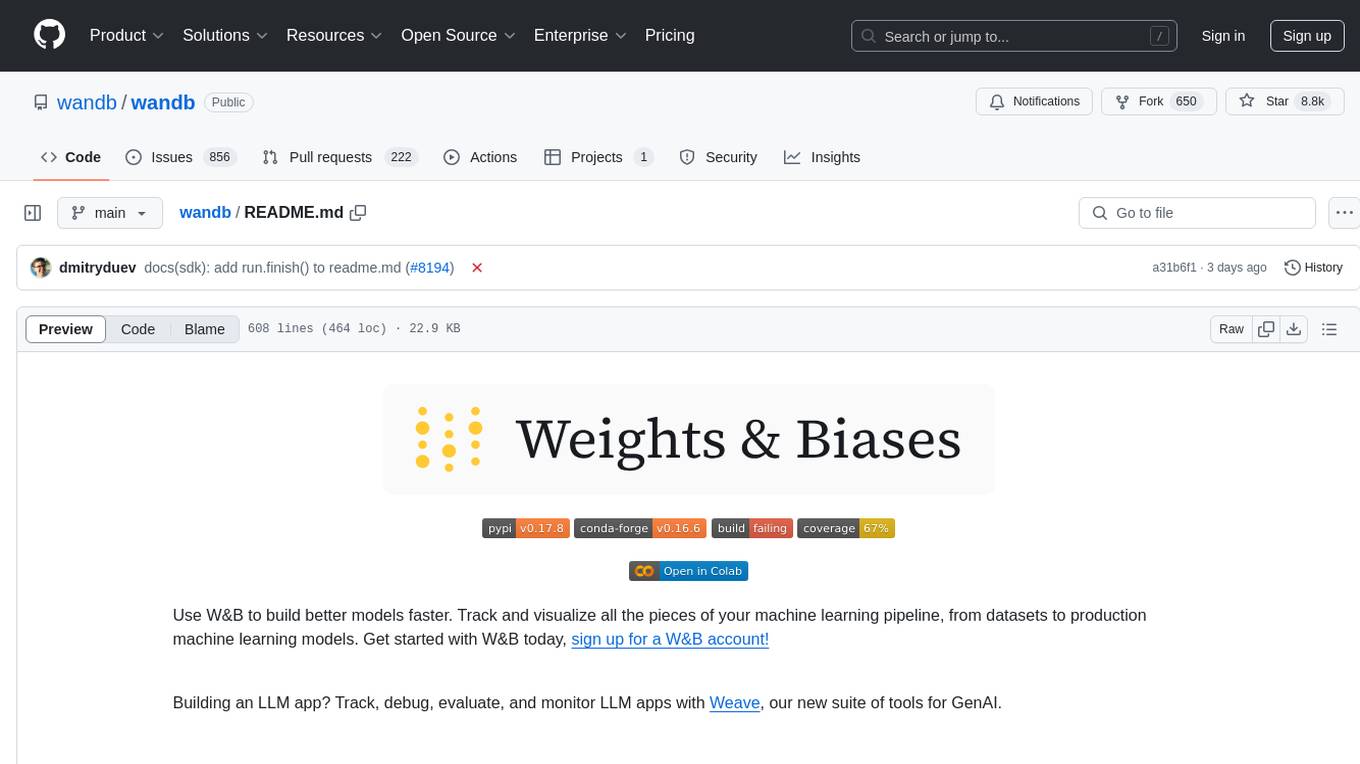
wandb
Weights & Biases (W&B) is a platform that helps users build better machine learning models faster by tracking and visualizing all components of the machine learning pipeline, from datasets to production models. It offers tools for tracking, debugging, evaluating, and monitoring machine learning applications. W&B provides integrations with popular frameworks like PyTorch, TensorFlow/Keras, Hugging Face Transformers, PyTorch Lightning, XGBoost, and Sci-Kit Learn. Users can easily log metrics, visualize performance, and compare experiments using W&B. The platform also supports hosting options in the cloud or on private infrastructure, making it versatile for various deployment needs.
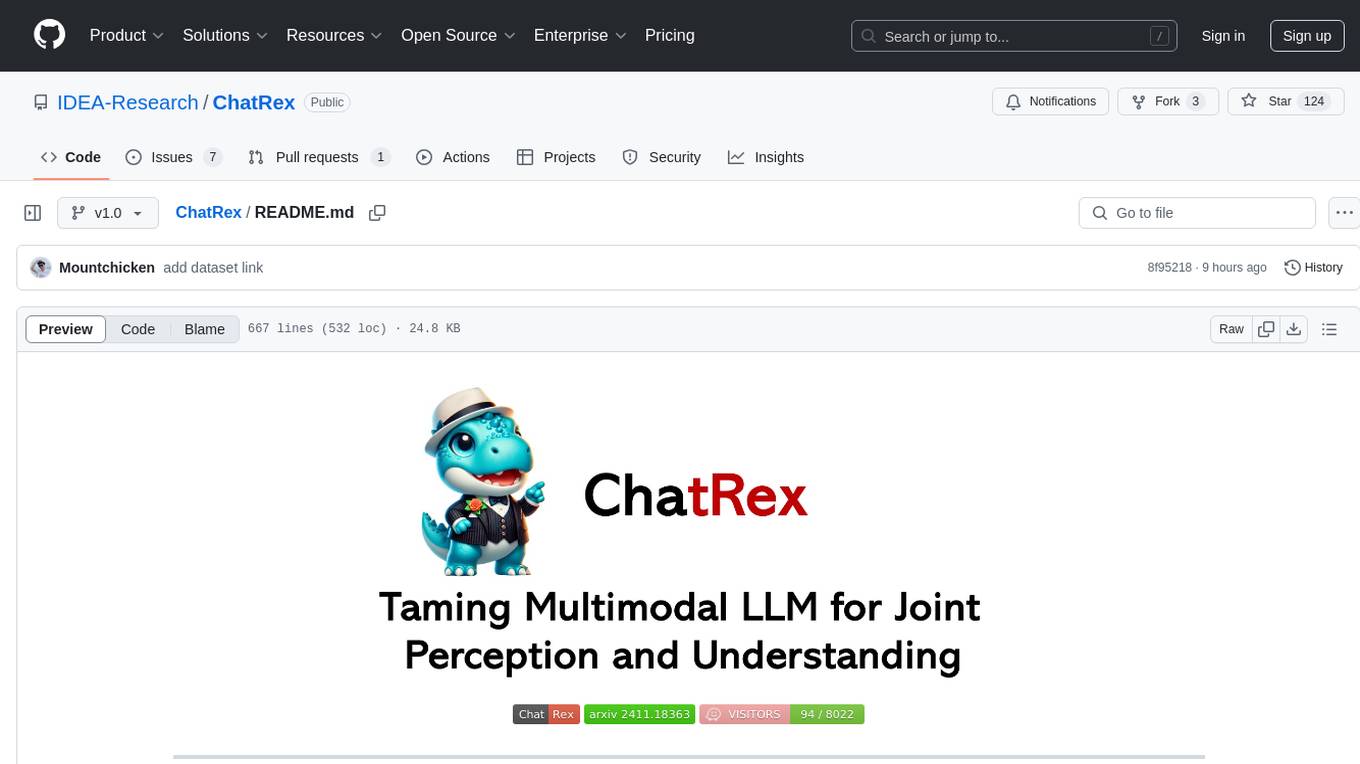
ChatRex
ChatRex is a Multimodal Large Language Model (MLLM) designed to seamlessly integrate fine-grained object perception and robust language understanding. By adopting a decoupled architecture with a retrieval-based approach for object detection and leveraging high-resolution visual inputs, ChatRex addresses key challenges in perception tasks. It is powered by the Rexverse-2M dataset with diverse image-region-text annotations. ChatRex can be applied to various scenarios requiring fine-grained perception, such as object detection, grounded conversation, grounded image captioning, and region understanding.
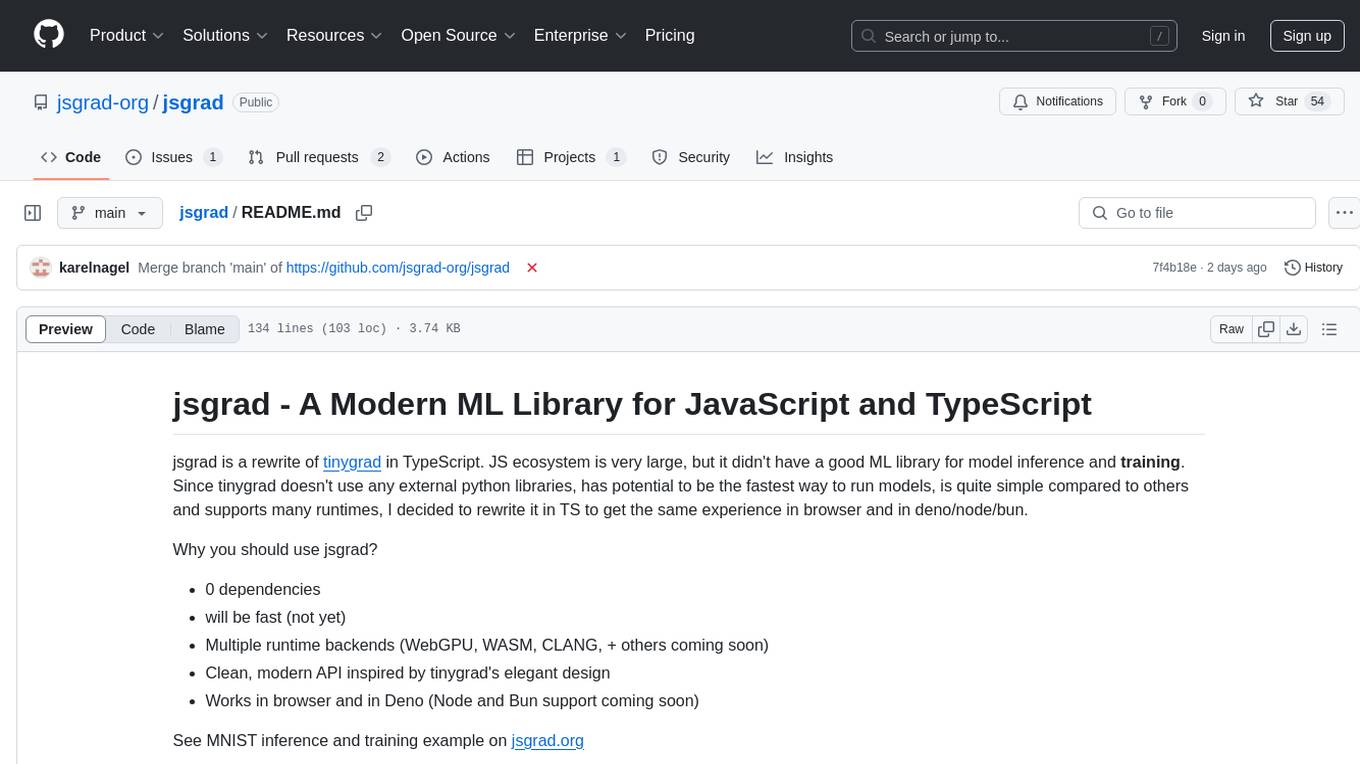
jsgrad
jsgrad is a modern ML library for JavaScript and TypeScript that aims to provide a fast and efficient way to run and train machine learning models. It is a rewrite of tinygrad in TypeScript, offering a clean and modern API with zero dependencies. The library supports multiple runtime backends such as WebGPU, WASM, and CLANG, making it versatile for various applications in browser and server environments. With a focus on simplicity and performance, jsgrad is designed to be easy to use for both model inference and training tasks.
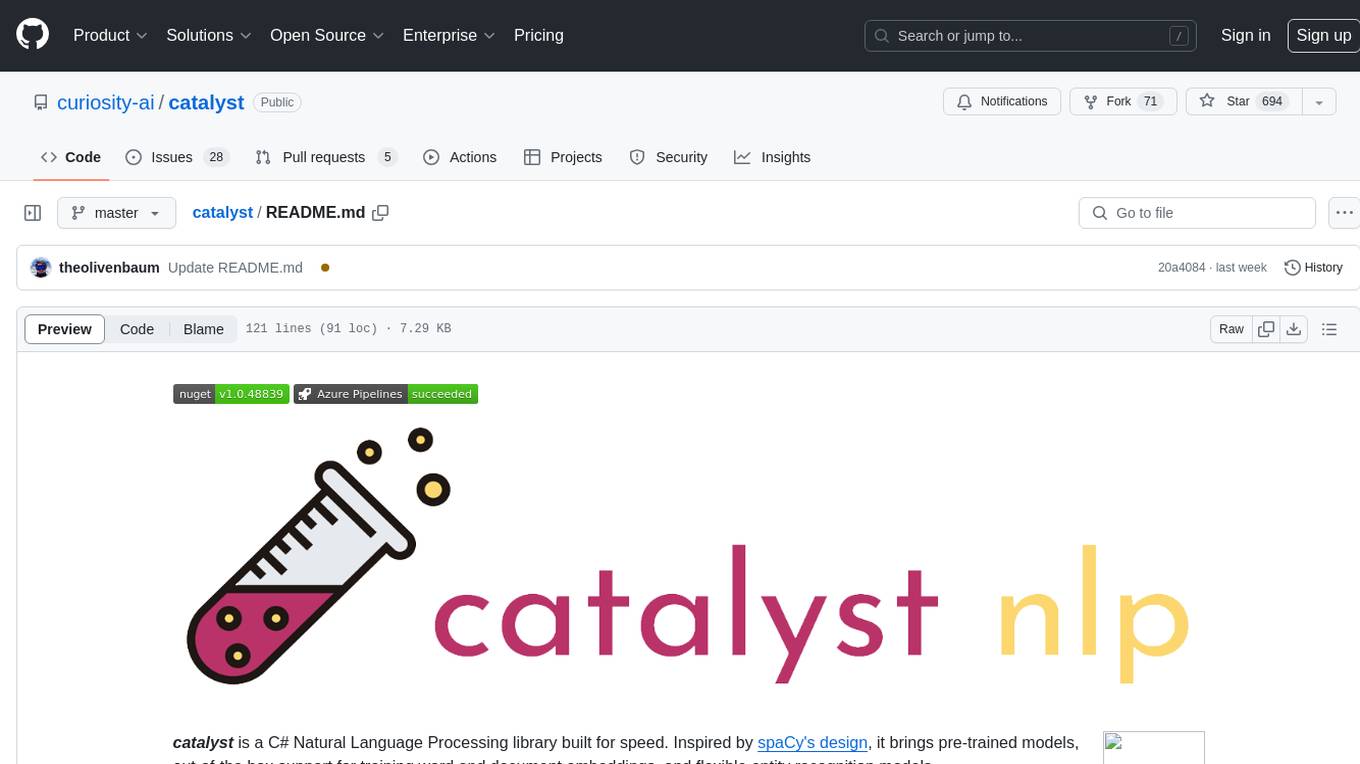
catalyst
Catalyst is a C# Natural Language Processing library designed for speed, inspired by spaCy's design. It provides pre-trained models, support for training word and document embeddings, and flexible entity recognition models. The library is fast, modern, and pure-C#, supporting .NET standard 2.0. It is cross-platform, running on Windows, Linux, macOS, and ARM. Catalyst offers non-destructive tokenization, named entity recognition, part-of-speech tagging, language detection, and efficient binary serialization. It includes pre-built models for language packages and lemmatization. Users can store and load models using streams. Getting started with Catalyst involves installing its NuGet Package and setting the storage to use the online repository. The library supports lazy loading of models from disk or online. Users can take advantage of C# lazy evaluation and native multi-threading support to process documents in parallel. Training a new FastText word2vec embedding model is straightforward, and Catalyst also provides algorithms for fast embedding search and dimensionality reduction.

simple-openai
Simple-OpenAI is a Java library that provides a simple way to interact with the OpenAI API. It offers consistent interfaces for various OpenAI services like Audio, Chat Completion, Image Generation, and more. The library uses CleverClient for HTTP communication, Jackson for JSON parsing, and Lombok to reduce boilerplate code. It supports asynchronous requests and provides methods for synchronous calls as well. Users can easily create objects to communicate with the OpenAI API and perform tasks like text-to-speech, transcription, image generation, and chat completions.
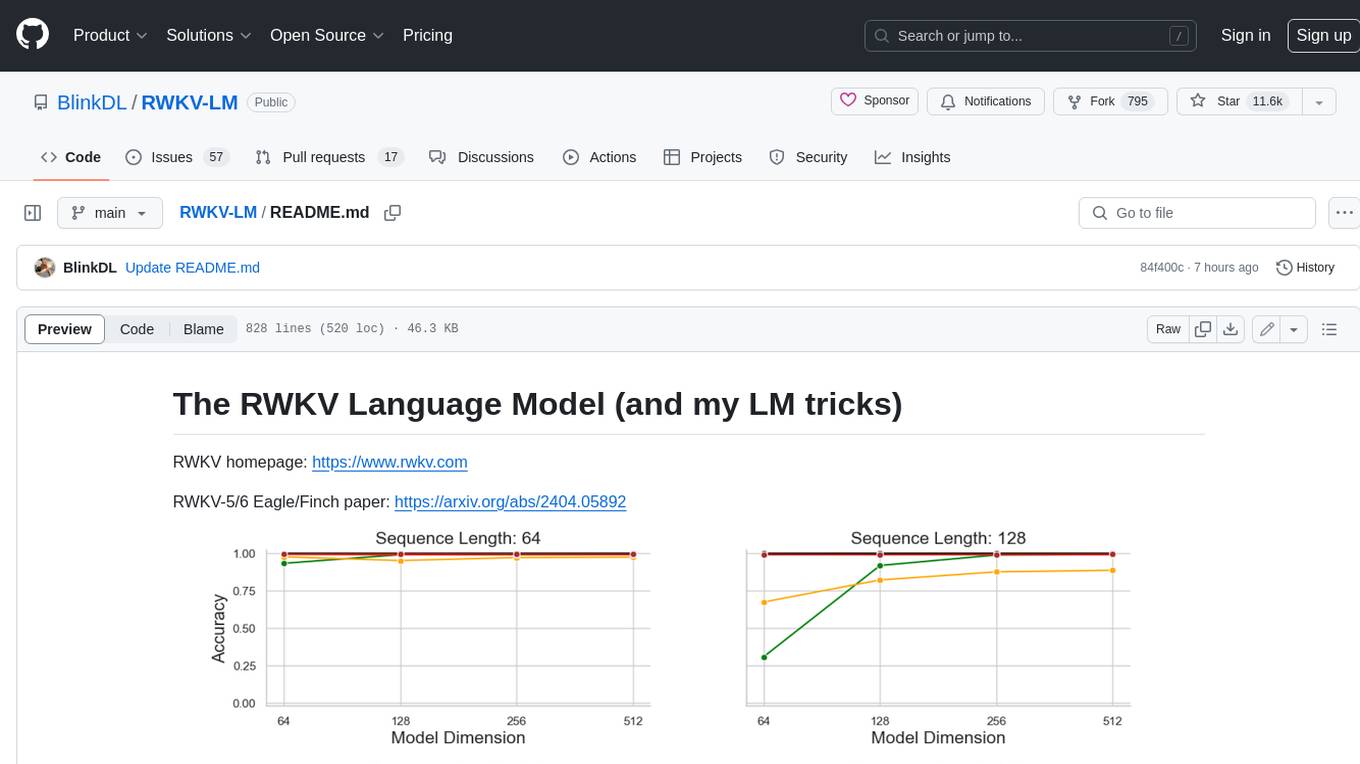
RWKV-LM
RWKV is an RNN with Transformer-level LLM performance, which can also be directly trained like a GPT transformer (parallelizable). And it's 100% attention-free. You only need the hidden state at position t to compute the state at position t+1. You can use the "GPT" mode to quickly compute the hidden state for the "RNN" mode. So it's combining the best of RNN and transformer - **great performance, fast inference, saves VRAM, fast training, "infinite" ctx_len, and free sentence embedding** (using the final hidden state).
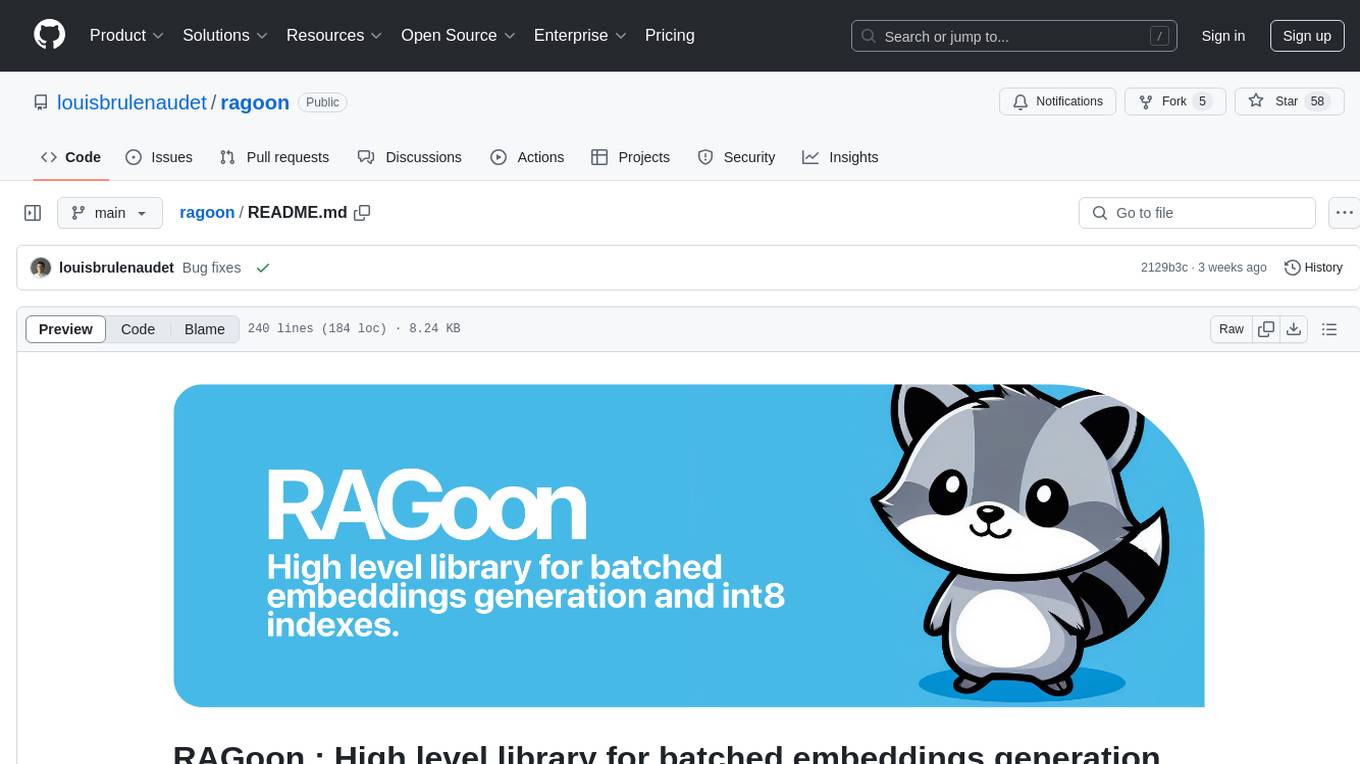
ragoon
RAGoon is a high-level library designed for batched embeddings generation, fast web-based RAG (Retrieval-Augmented Generation) processing, and quantized indexes processing. It provides NLP utilities for multi-model embedding production, high-dimensional vector visualization, and enhancing language model performance through search-based querying, web scraping, and data augmentation techniques.
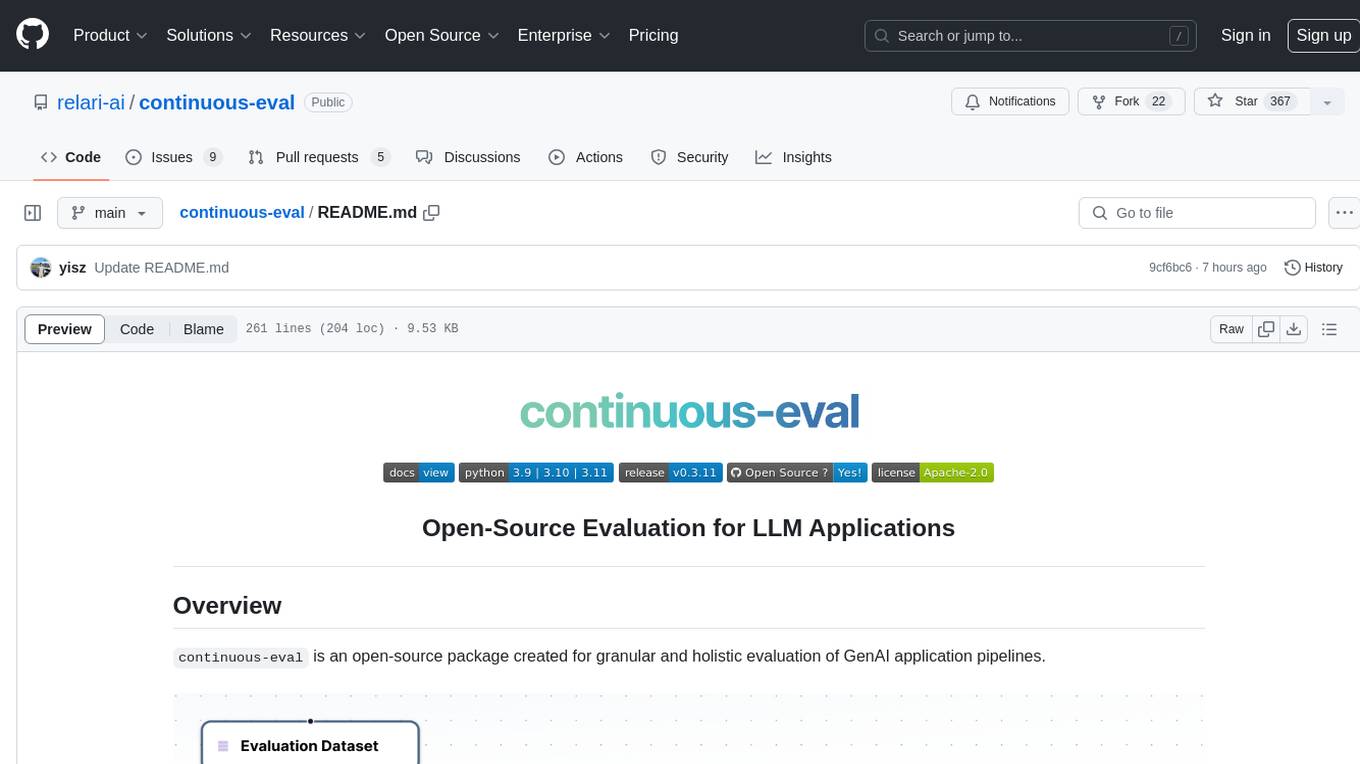
continuous-eval
Open-Source Evaluation for LLM Applications. `continuous-eval` is an open-source package created for granular and holistic evaluation of GenAI application pipelines. It offers modularized evaluation, a comprehensive metric library covering various LLM use cases, the ability to leverage user feedback in evaluation, and synthetic dataset generation for testing pipelines. Users can define their own metrics by extending the Metric class. The tool allows running evaluation on a pipeline defined with modules and corresponding metrics. Additionally, it provides synthetic data generation capabilities to create user interaction data for evaluation or training purposes.
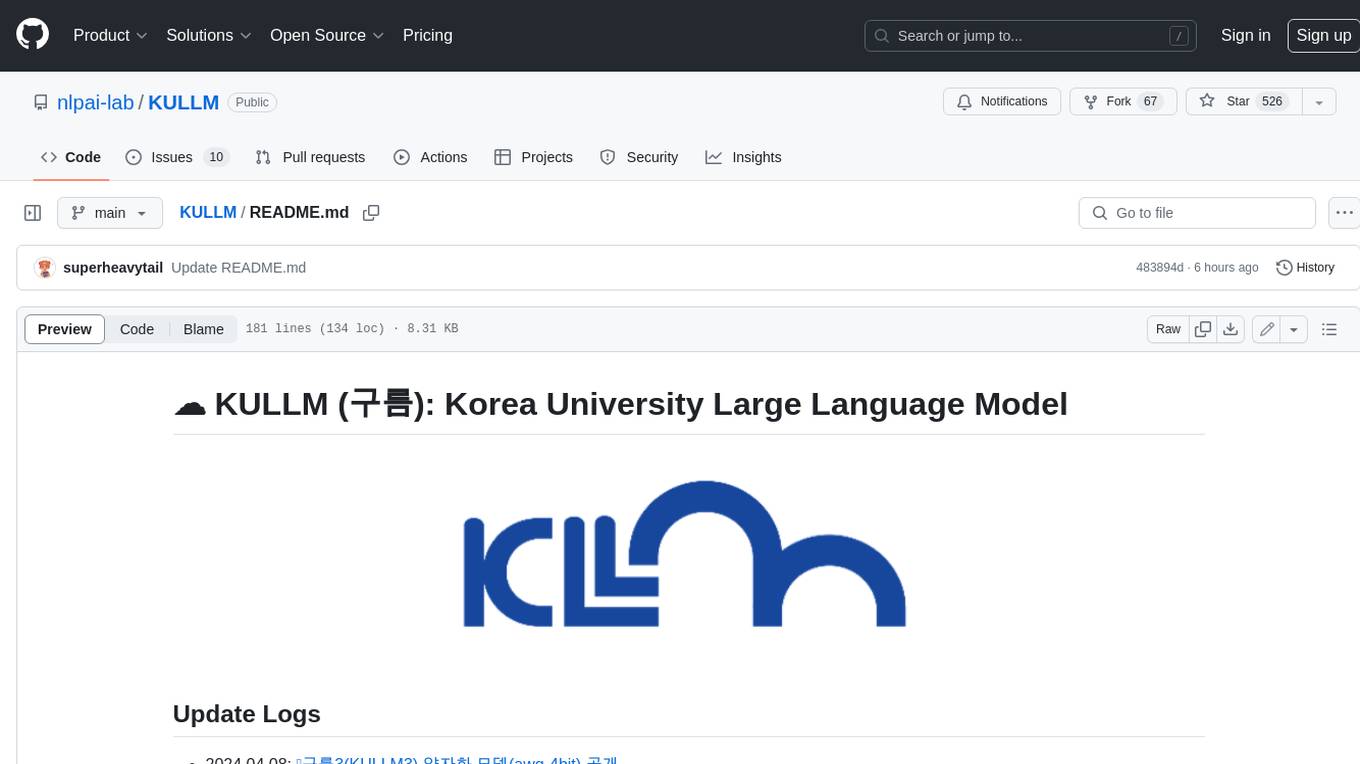
KULLM
KULLM (구름) is a Korean Large Language Model developed by Korea University NLP & AI Lab and HIAI Research Institute. It is based on the upstage/SOLAR-10.7B-v1.0 model and has been fine-tuned for instruction. The model has been trained on 8×A100 GPUs and is capable of generating responses in Korean language. KULLM exhibits hallucination and repetition phenomena due to its decoding strategy. Users should be cautious as the model may produce inaccurate or harmful results. Performance may vary in benchmarks without a fixed system prompt.
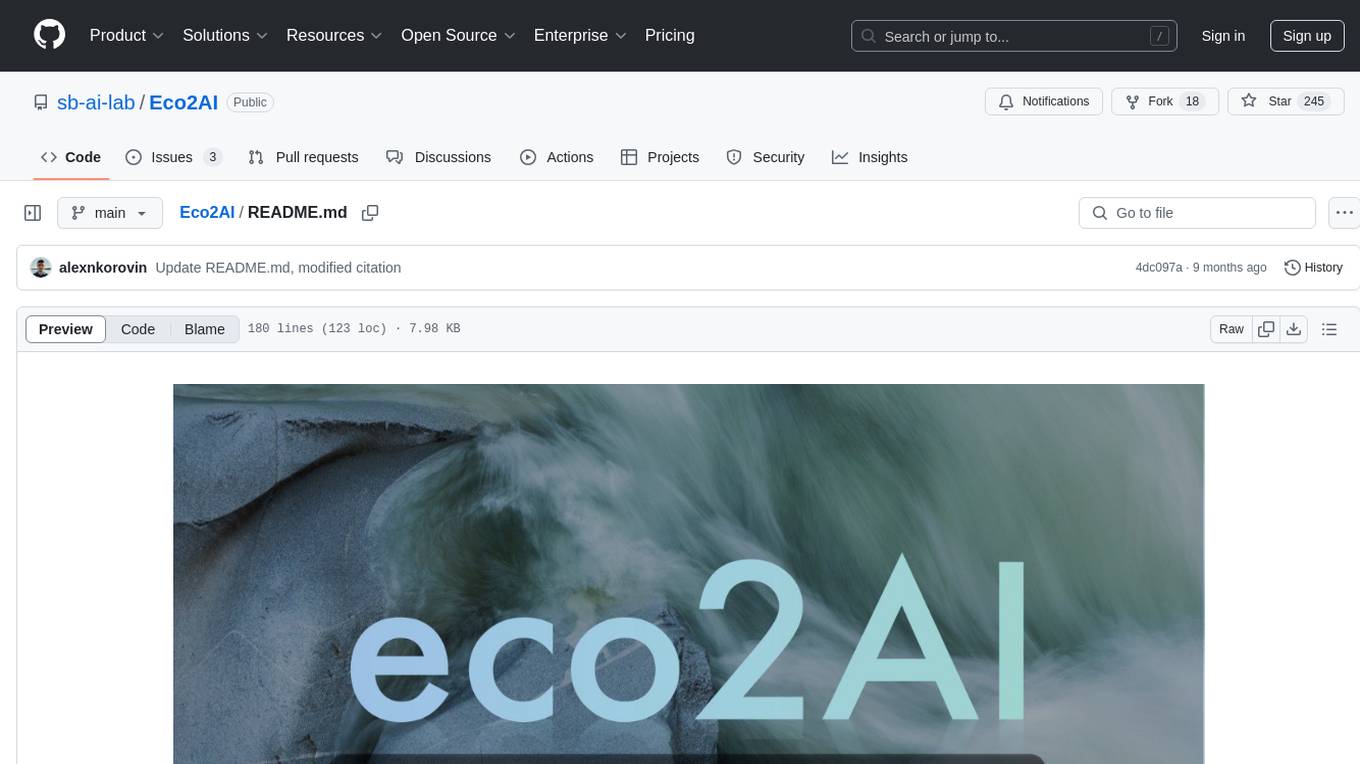
Eco2AI
Eco2AI is a python library for CO2 emission tracking that monitors energy consumption of CPU & GPU devices and estimates equivalent carbon emissions based on regional emission coefficients. Users can easily integrate Eco2AI into their Python scripts by adding a few lines of code. The library records emissions data and device information in a local file, providing detailed session logs with project names, experiment descriptions, start times, durations, power consumption, CO2 emissions, CPU and GPU names, operating systems, and countries.
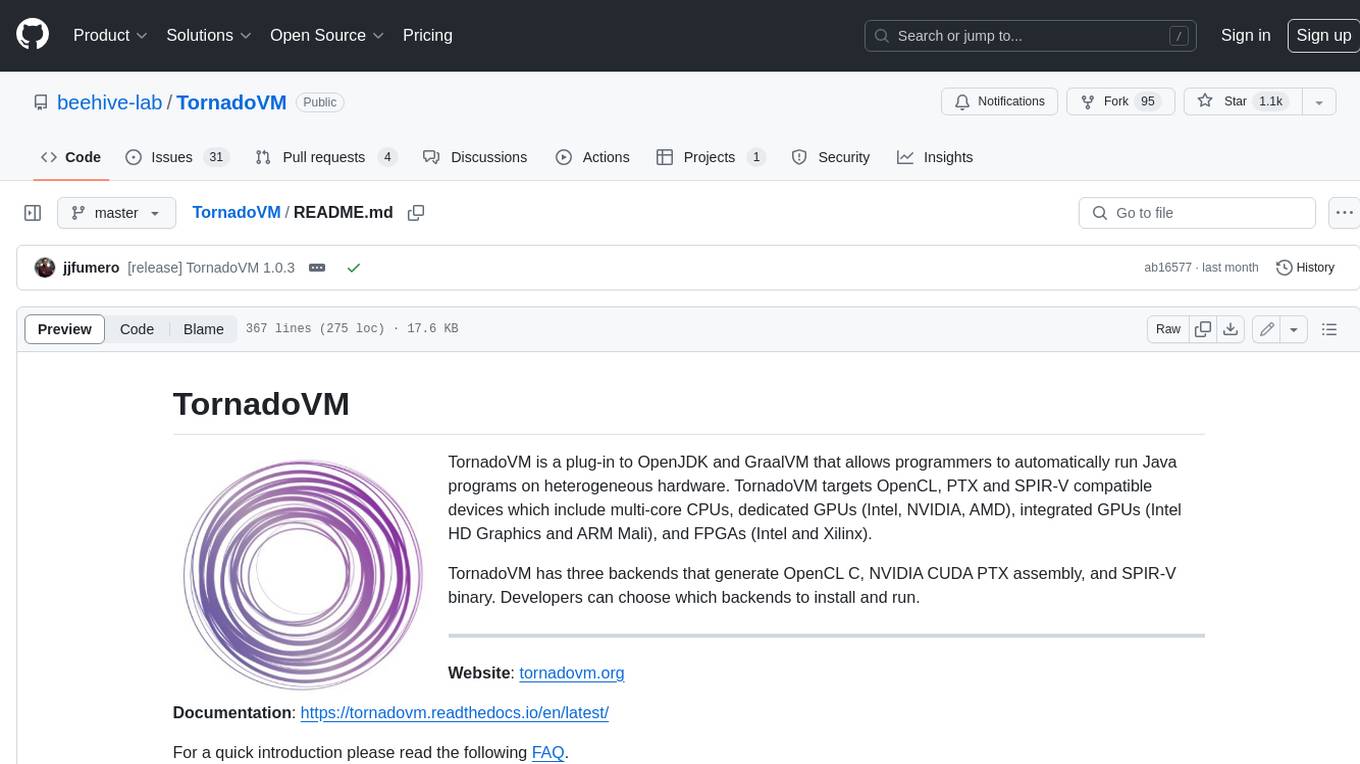
TornadoVM
TornadoVM is a plug-in to OpenJDK and GraalVM that allows programmers to automatically run Java programs on heterogeneous hardware. TornadoVM targets OpenCL, PTX and SPIR-V compatible devices which include multi-core CPUs, dedicated GPUs (Intel, NVIDIA, AMD), integrated GPUs (Intel HD Graphics and ARM Mali), and FPGAs (Intel and Xilinx).
For similar tasks

zeta
Zeta is a tool designed to build state-of-the-art AI models faster by providing modular, high-performance, and scalable building blocks. It addresses the common issues faced while working with neural nets, such as chaotic codebases, lack of modularity, and low performance modules. Zeta emphasizes usability, modularity, and performance, and is currently used in hundreds of models across various GitHub repositories. It enables users to prototype, train, optimize, and deploy the latest SOTA neural nets into production. The tool offers various modules like FlashAttention, SwiGLUStacked, RelativePositionBias, FeedForward, BitLinear, PalmE, Unet, VisionEmbeddings, niva, FusedDenseGELUDense, FusedDropoutLayerNorm, MambaBlock, Film, hyper_optimize, DPO, and ZetaCloud for different tasks in AI model development.
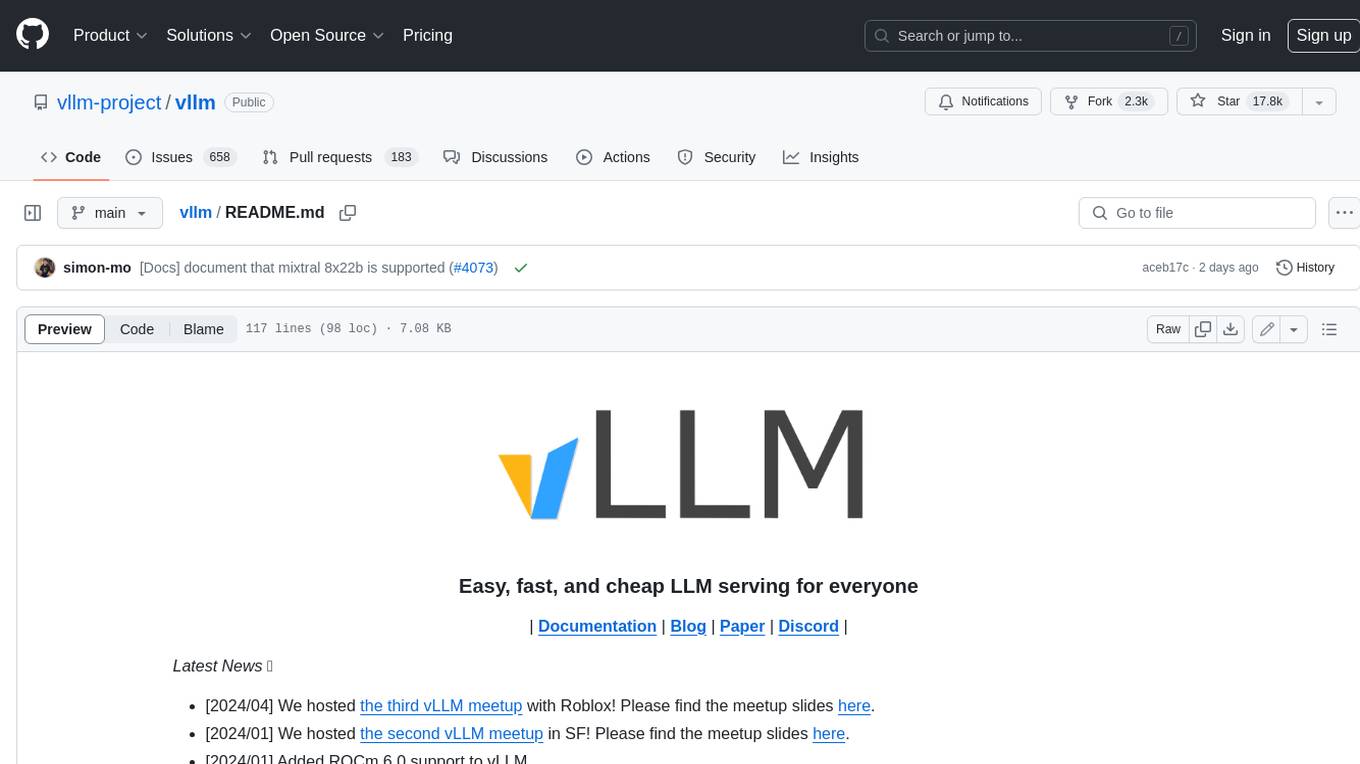
vllm
vLLM is a fast and easy-to-use library for LLM inference and serving. It is designed to be efficient, flexible, and easy to use. vLLM can be used to serve a variety of LLM models, including Hugging Face models. It supports a variety of decoding algorithms, including parallel sampling, beam search, and more. vLLM also supports tensor parallelism for distributed inference and streaming outputs. It is open-source and available on GitHub.
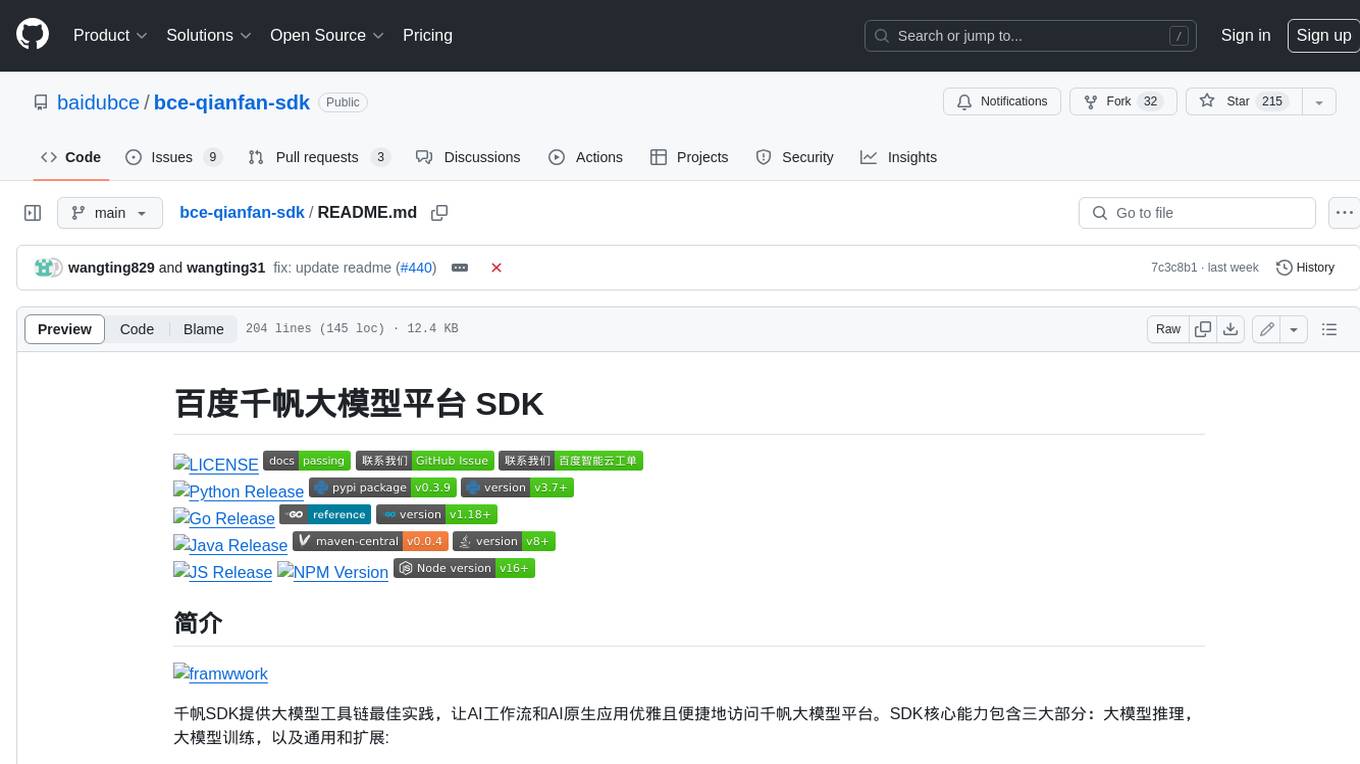
bce-qianfan-sdk
The Qianfan SDK provides best practices for large model toolchains, allowing AI workflows and AI-native applications to access the Qianfan large model platform elegantly and conveniently. The core capabilities of the SDK include three parts: large model reasoning, large model training, and general and extension: * `Large model reasoning`: Implements interface encapsulation for reasoning of Yuyan (ERNIE-Bot) series, open source large models, etc., supporting dialogue, completion, Embedding, etc. * `Large model training`: Based on platform capabilities, it supports end-to-end large model training process, including training data, fine-tuning/pre-training, and model services. * `General and extension`: General capabilities include common AI development tools such as Prompt/Debug/Client. The extension capability is based on the characteristics of Qianfan to adapt to common middleware frameworks.
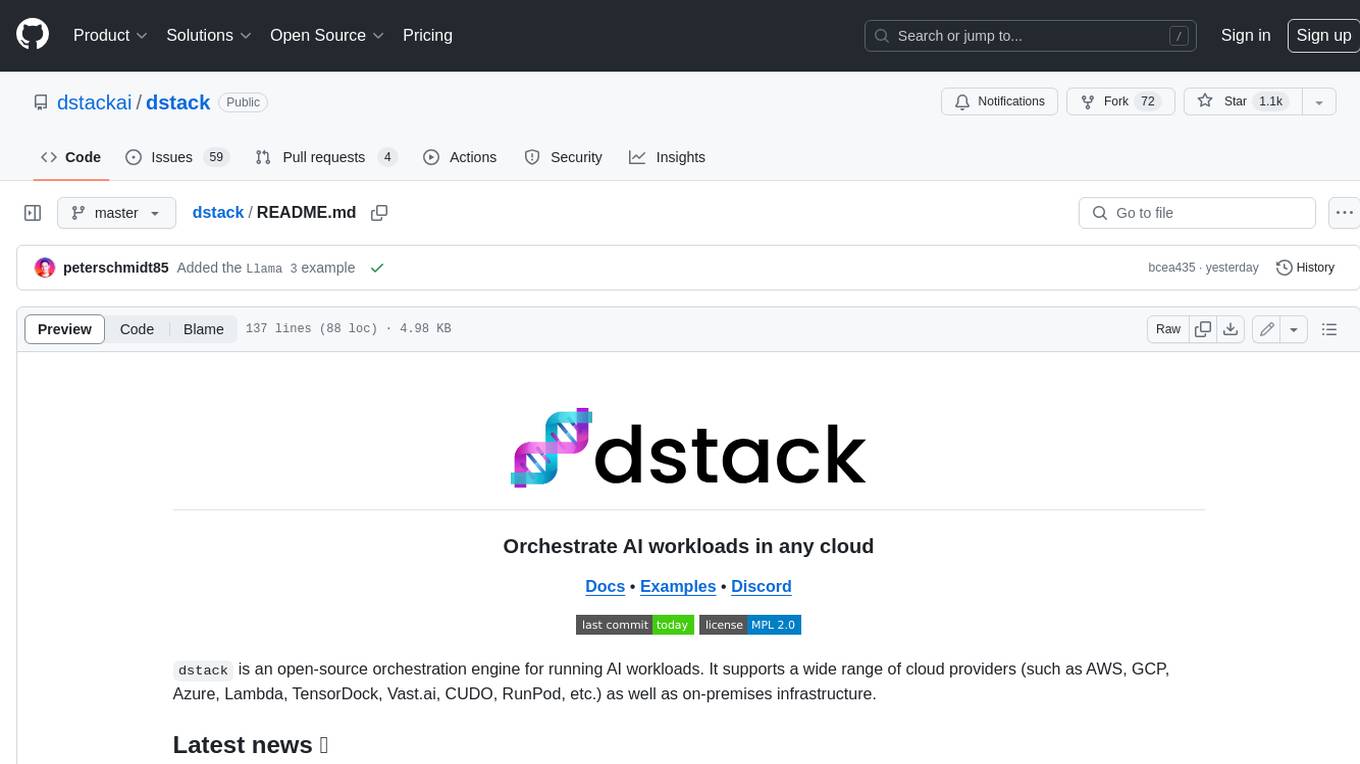
dstack
Dstack is an open-source orchestration engine for running AI workloads in any cloud. It supports a wide range of cloud providers (such as AWS, GCP, Azure, Lambda, TensorDock, Vast.ai, CUDO, RunPod, etc.) as well as on-premises infrastructure. With Dstack, you can easily set up and manage dev environments, tasks, services, and pools for your AI workloads.
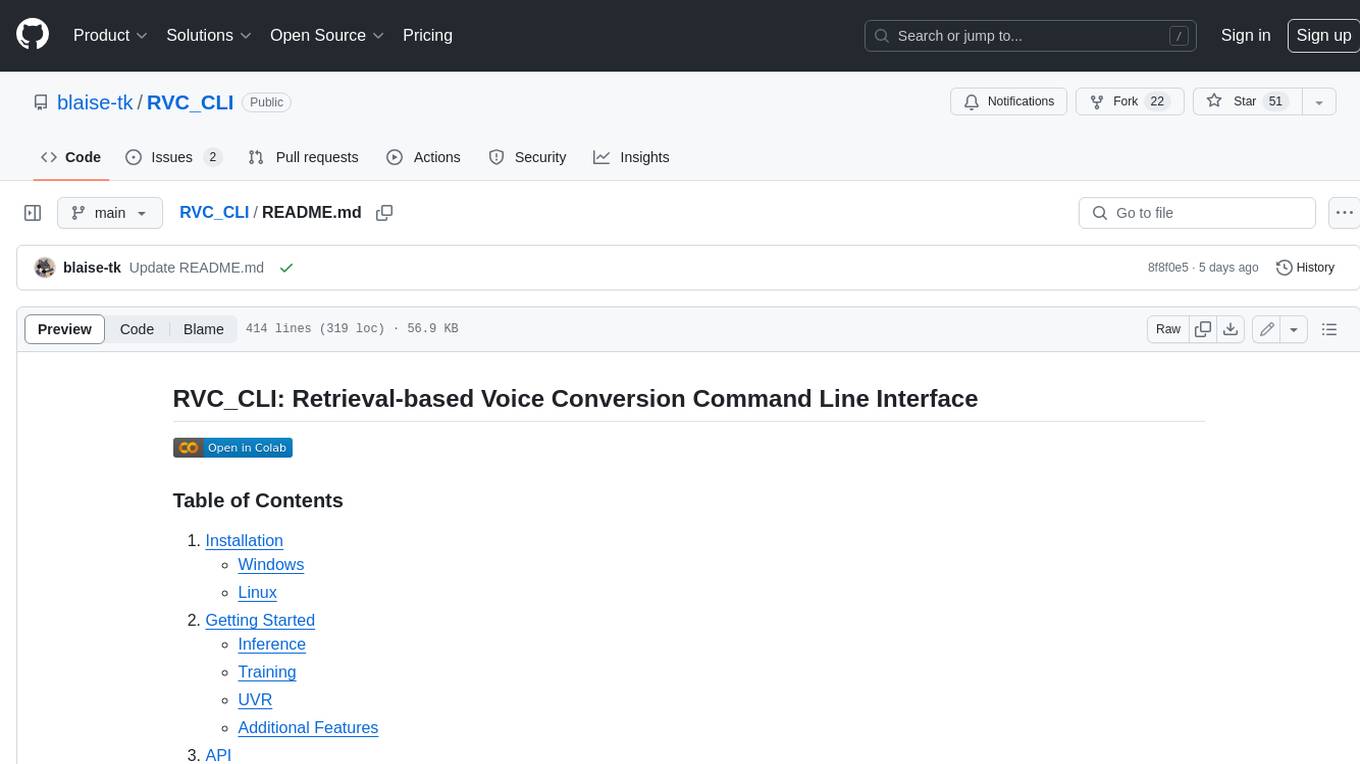
RVC_CLI
**RVC_CLI: Retrieval-based Voice Conversion Command Line Interface** This command-line interface (CLI) provides a comprehensive set of tools for voice conversion, enabling you to modify the pitch, timbre, and other characteristics of audio recordings. It leverages advanced machine learning models to achieve realistic and high-quality voice conversions. **Key Features:** * **Inference:** Convert the pitch and timbre of audio in real-time or process audio files in batch mode. * **TTS Inference:** Synthesize speech from text using a variety of voices and apply voice conversion techniques. * **Training:** Train custom voice conversion models to meet specific requirements. * **Model Management:** Extract, blend, and analyze models to fine-tune and optimize performance. * **Audio Analysis:** Inspect audio files to gain insights into their characteristics. * **API:** Integrate the CLI's functionality into your own applications or workflows. **Applications:** The RVC_CLI finds applications in various domains, including: * **Music Production:** Create unique vocal effects, harmonies, and backing vocals. * **Voiceovers:** Generate voiceovers with different accents, emotions, and styles. * **Audio Editing:** Enhance or modify audio recordings for podcasts, audiobooks, and other content. * **Research and Development:** Explore and advance the field of voice conversion technology. **For Jobs:** * Audio Engineer * Music Producer * Voiceover Artist * Audio Editor * Machine Learning Engineer **AI Keywords:** * Voice Conversion * Pitch Shifting * Timbre Modification * Machine Learning * Audio Processing **For Tasks:** * Convert Pitch * Change Timbre * Synthesize Speech * Train Model * Analyze Audio
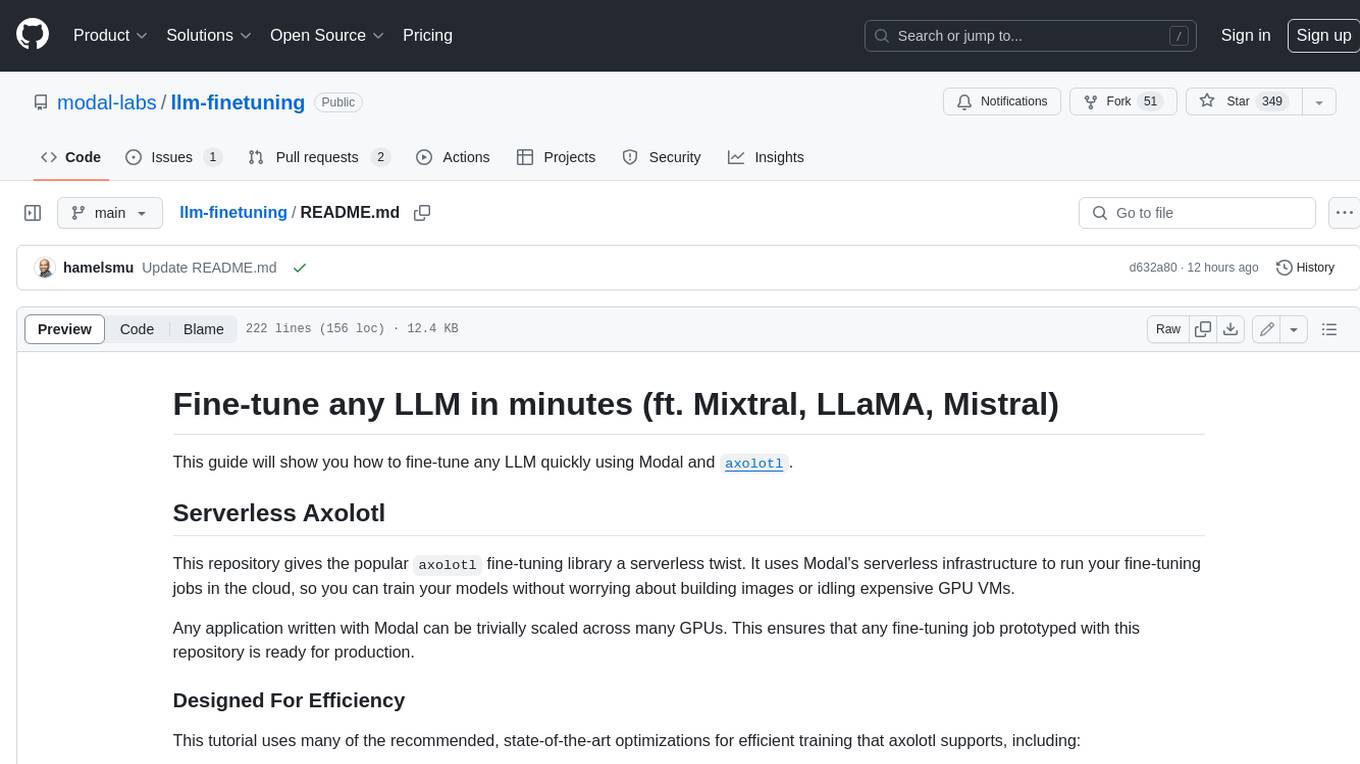
llm-finetuning
llm-finetuning is a repository that provides a serverless twist to the popular axolotl fine-tuning library using Modal's serverless infrastructure. It allows users to quickly fine-tune any LLM model with state-of-the-art optimizations like Deepspeed ZeRO, LoRA adapters, Flash attention, and Gradient checkpointing. The repository simplifies the fine-tuning process by not exposing all CLI arguments, instead allowing users to specify options in a config file. It supports efficient training and scaling across multiple GPUs, making it suitable for production-ready fine-tuning jobs.
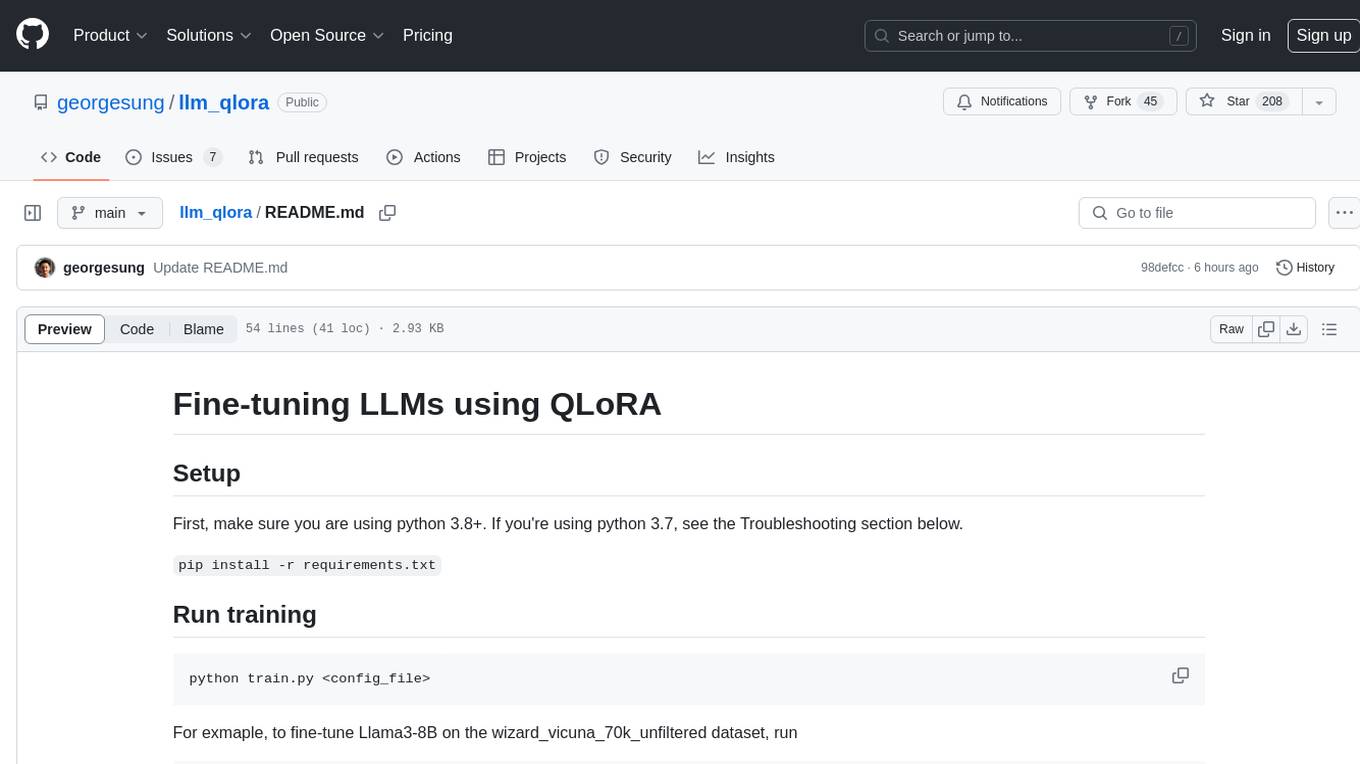
llm_qlora
LLM_QLoRA is a repository for fine-tuning Large Language Models (LLMs) using QLoRA methodology. It provides scripts for training LLMs on custom datasets, pushing models to HuggingFace Hub, and performing inference. Additionally, it includes models trained on HuggingFace Hub, a blog post detailing the QLoRA fine-tuning process, and instructions for converting and quantizing models. The repository also addresses troubleshooting issues related to Python versions and dependencies.
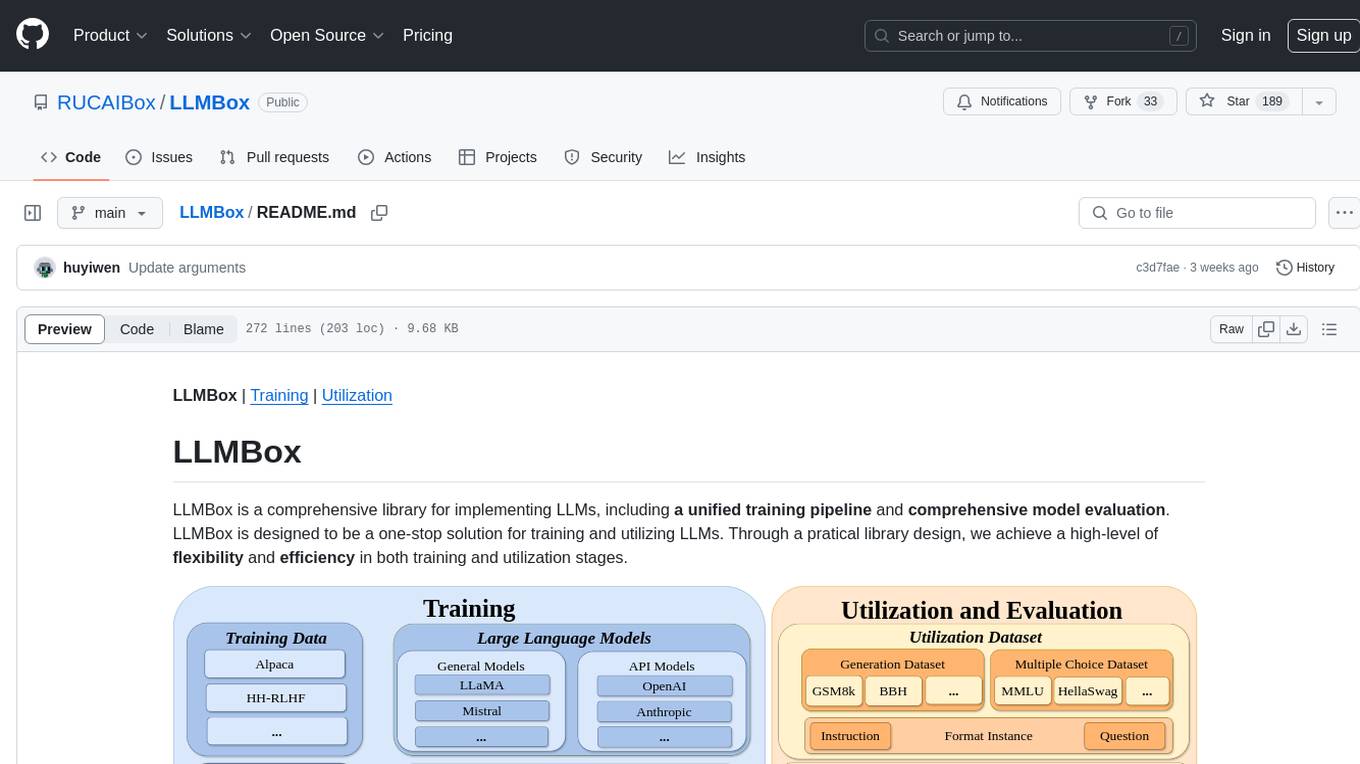
LLMBox
LLMBox is a comprehensive library designed for implementing Large Language Models (LLMs) with a focus on a unified training pipeline and comprehensive model evaluation. It serves as a one-stop solution for training and utilizing LLMs, offering flexibility and efficiency in both training and utilization stages. The library supports diverse training strategies, comprehensive datasets, tokenizer vocabulary merging, data construction strategies, parameter efficient fine-tuning, and efficient training methods. For utilization, LLMBox provides comprehensive evaluation on various datasets, in-context learning strategies, chain-of-thought evaluation, evaluation methods, prefix caching for faster inference, support for specific LLM models like vLLM and Flash Attention, and quantization options. The tool is suitable for researchers and developers working with LLMs for natural language processing tasks.
For similar jobs

zeta
Zeta is a tool designed to build state-of-the-art AI models faster by providing modular, high-performance, and scalable building blocks. It addresses the common issues faced while working with neural nets, such as chaotic codebases, lack of modularity, and low performance modules. Zeta emphasizes usability, modularity, and performance, and is currently used in hundreds of models across various GitHub repositories. It enables users to prototype, train, optimize, and deploy the latest SOTA neural nets into production. The tool offers various modules like FlashAttention, SwiGLUStacked, RelativePositionBias, FeedForward, BitLinear, PalmE, Unet, VisionEmbeddings, niva, FusedDenseGELUDense, FusedDropoutLayerNorm, MambaBlock, Film, hyper_optimize, DPO, and ZetaCloud for different tasks in AI model development.

weave
Weave is a toolkit for developing Generative AI applications, built by Weights & Biases. With Weave, you can log and debug language model inputs, outputs, and traces; build rigorous, apples-to-apples evaluations for language model use cases; and organize all the information generated across the LLM workflow, from experimentation to evaluations to production. Weave aims to bring rigor, best-practices, and composability to the inherently experimental process of developing Generative AI software, without introducing cognitive overhead.

LLMStack
LLMStack is a no-code platform for building generative AI agents, workflows, and chatbots. It allows users to connect their own data, internal tools, and GPT-powered models without any coding experience. LLMStack can be deployed to the cloud or on-premise and can be accessed via HTTP API or triggered from Slack or Discord.

VisionCraft
The VisionCraft API is a free API for using over 100 different AI models. From images to sound.

kaito
Kaito is an operator that automates the AI/ML inference model deployment in a Kubernetes cluster. It manages large model files using container images, avoids tuning deployment parameters to fit GPU hardware by providing preset configurations, auto-provisions GPU nodes based on model requirements, and hosts large model images in the public Microsoft Container Registry (MCR) if the license allows. Using Kaito, the workflow of onboarding large AI inference models in Kubernetes is largely simplified.

PyRIT
PyRIT is an open access automation framework designed to empower security professionals and ML engineers to red team foundation models and their applications. It automates AI Red Teaming tasks to allow operators to focus on more complicated and time-consuming tasks and can also identify security harms such as misuse (e.g., malware generation, jailbreaking), and privacy harms (e.g., identity theft). The goal is to allow researchers to have a baseline of how well their model and entire inference pipeline is doing against different harm categories and to be able to compare that baseline to future iterations of their model. This allows them to have empirical data on how well their model is doing today, and detect any degradation of performance based on future improvements.

tabby
Tabby is a self-hosted AI coding assistant, offering an open-source and on-premises alternative to GitHub Copilot. It boasts several key features: * Self-contained, with no need for a DBMS or cloud service. * OpenAPI interface, easy to integrate with existing infrastructure (e.g Cloud IDE). * Supports consumer-grade GPUs.

spear
SPEAR (Simulator for Photorealistic Embodied AI Research) is a powerful tool for training embodied agents. It features 300 unique virtual indoor environments with 2,566 unique rooms and 17,234 unique objects that can be manipulated individually. Each environment is designed by a professional artist and features detailed geometry, photorealistic materials, and a unique floor plan and object layout. SPEAR is implemented as Unreal Engine assets and provides an OpenAI Gym interface for interacting with the environments via Python.




















